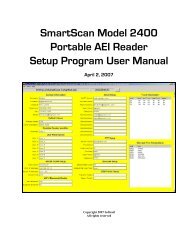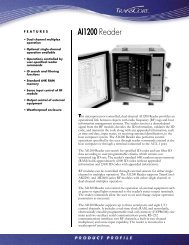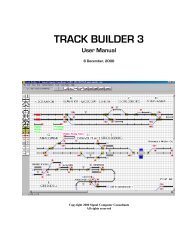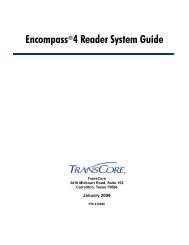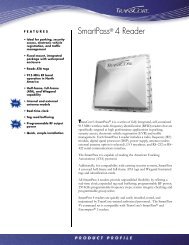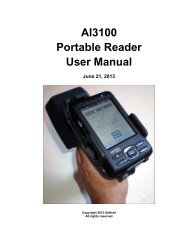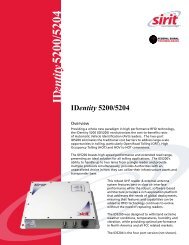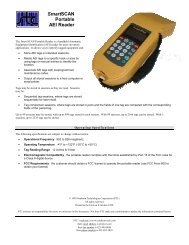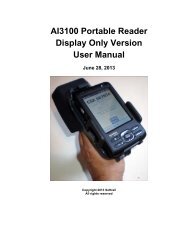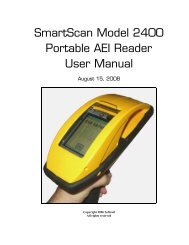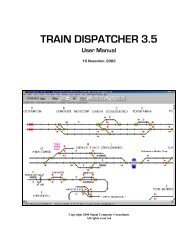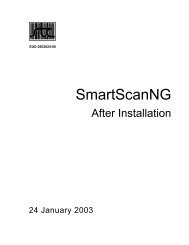Train Dispatcher 3 Manual - Signal Computer Consultants
Train Dispatcher 3 Manual - Signal Computer Consultants
Train Dispatcher 3 Manual - Signal Computer Consultants
- No tags were found...
You also want an ePaper? Increase the reach of your titles
YUMPU automatically turns print PDFs into web optimized ePapers that Google loves.
<strong>Train</strong> <strong>Dispatcher</strong> 3♦♦♦♦♦♦Run Time Performance - Even though the signaling system and operating rules dictate how fast a train shouldtravel, locomotive engineers operate differently. This parameter sets by how much train speed will deviate fromexpected speed. If this field is set to 10, for example, the trains’ speeds will deviate +-10% from the expectedspeed. A train, therefore, with an expected speed of 60 miles per hour will be assigned a random speedbetween 54 and 66 miles per hour. If this parameter is set to zero, the trains will always travel at the expectedspeeds.The random speed deviation for a particular train type applies from the time it enters the territory until it existsthe territory. Therefore, a train will travel through all blocks at the same percentage deviation from theexpected speed.Startup Delays - Stopped trains do not always immediately start to move when a signal is cleared. The trainstartup time can be affected by the weight of the train, the slope of the track, and the locomotive engineer’sresponse time. When this parameter is checked, a random startup time for the train will be generated basedon the normal start up time for that train type.Late train arrival - <strong>Train</strong>s will not always arrive on the territory at the scheduled time. This parameter sets thepercentage of trains that will be late arriving on the territory. If this parameter is set to zero, all trains willarrive on the territory on time.The amount of time a train can be late deviates from 1 minute to 9 hours and 59 minutes. The algorithm usedto calculate the lateness of a train causes lower time delays to be assigned more often than higher ones. Forexample, 50% of all time delays will be less than one hour, 75% less than 2 hours, 87.5% less than 3 hours,etc.Locomotive Problems – <strong>Train</strong>s can have problems with one or more of their locomotives that will affect theperformance of the train. The number entered into this parameter indicates the percentage of trains on theterritory that will have locomotive problems. For example, if this parameter set to 0, none will; if it is set to 50,then 50 percent of the trains will develop locomotive problems.<strong>Train</strong> Problems – <strong>Train</strong>s can have problems such as broken air hoses. When a problem of this type occursthe train must stop and the crew will have to fix the problem before it can move again. As above, the numberentered into this field indicates the percentage of trains on the territory that will have this type of problem.Dropped <strong>Signal</strong> Derailment - One of the most dangerous things a train dispatcher can do is drop a signal(abruptly change the signal from cleared to stop) in front of a moving train. This parameter determines thepercentage of trains moving at speeds greater than 35 miles per hour that will be de-railed if the dispatcherdrops a signal in front of them. For trains traveling less than 35 miles per hour, the percentage that will de-railwill be half of this parameter. <strong>Train</strong>s already stopped when a signal is dropped will obviously not be de-railed.Derailed trains will be stopped for a period of between 2 and 10 hours.8.1.2. Random Defect Detector ParametersTo enter the defect detector parameters for the random performance generator, select the “Random Defect DetectParameters” item under the “Random” menu. Figure 34 will appear.Page 346 December, 2000



